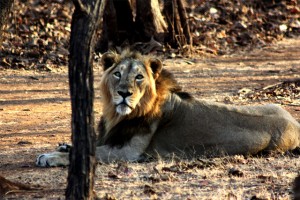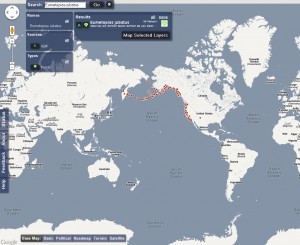Search Results for Tag: wildlife
India poll workers brave wild animals to reach voters
Braving hungry crocodiles, Asiatic lions, wild elephants and traveling in camel caravans– sound like an Indiana Jones movie? It’s what some election officials in India have faced in recent days trying to do their job.
 This Asiatic lion, along with other wildlife, awaited an election team in the Gir forest in Gujarat (Photo credit: CC BY 2.0: Shaunak Modi)
This Asiatic lion, along with other wildlife, awaited an election team in the Gir forest in Gujarat (Photo credit: CC BY 2.0: Shaunak Modi)
Pulling off a parliamentary election in the world’s largest democracy is never an easy task. Apart from the mind-boggling logistics this time (814 million eligible voters; over 930,000 polling stations; nearly 6 million poll workers), India’s physical size and topographical diversity trigger an obstacle course for some poll workers. From snow-bound mountains in the northern Himalayas, the deserts of western Rajasthan, tropical jungles to tiny remote islands in the south, some poll officials have to navigate a variety of routes to ensure citizens can cast their votes. And, a few election officials have also had to brave the teeming wildlife that comes with the terrain.
One newspaper report, along with a video, detailed how election officials on the Andaman and Nicobar archipelago in the Indian Ocean – home to more than 550 islands, many of them heavily forested – recently got into canoes and undertook a three-hour journey on a river infested with crocodiles. Their job was to get to a remote village along with their two voting machines and set up a polling booth. The mission, though harrowing, was eventually successful. But election officer, Biswajit Roy, a veteran of national polls, told the Wall Street Journal: “In all my years, this by far was the toughest.”
There were also reports of officials trudging through tropical jungles inhabited by snakes and traveling in camel caravans to reach settlements in the Thar desert in northwestern Rajasthan. Big animals were also very much on the mind of a polling team that traveled to the Gir forest in the western state of Gujarat – home to the majestic Asiatic lion – to cater to a lone voter in a hamlet there. Election rules in India say there must be a polling station within two kilometers of every residential community.
And, earlier this month, election officials in the northeastern state of Meghalaya had to contend with a herd of wild elephants that blocked the way to two polling stations. They were eventually chased away into the jungle by forest rangers.
Are drones the next weapon against poaching?
In 2013 South Africa lost more than 1000 rhinos to illegal hunting. In other countries such as Vietnam, rhinos are already extinct. Now, a US company hopes to launch unmanned drones equipped with cameras to frighten off poachers.
Airware is a company that develops a new autopilot system for commercial drones. Those drones can be used for many different purposes, the company says. Such as inspections, search and rescue operations – or to watch out for poachers across large areas of African safari parks.
The company has conducted a field test in Kenya with drones designed to protect rhinos. First results suggest they may be a promising tool for wildlife conservation.
But why in Kenia? The country lost 50 rhinos in 2013. The team went to Ol Pejeta which is East Africa’s largest black rhino sanctuary. Set up to act as a deterrent and for surveillance the drone was sending real-time video and thermal imaging feeds to the rangers on the ground. The drone navigates autonomously, along a prescribed flight route and requires just one person to operate, who can also instruct the aircraft what to look out for with the on-board camera.
The test prototype “surpassed all our expectations,” the team said afterwards. Just maybe tech innovations like these could help to preserve threatened species.
And it is an effort, that is obviously more realistic than a concept by artist Robert Chew. He thought about robots that take the forms of (poached) animals to blend in with the wildlife and help capture poachers.
Mapping the world’s plant and animal life
 This can become one of the most interesting projects for people who are interested in nature, biodiversity and, of course, the impact climate change on our environment. A team of researchers from Yale and the University Colorado at Boulder have an unbelievable idea. Their plan is to map the distribution of all plant and animal life on earth. This May they have started a demo-version of their Web-based “Map of Life“.
This can become one of the most interesting projects for people who are interested in nature, biodiversity and, of course, the impact climate change on our environment. A team of researchers from Yale and the University Colorado at Boulder have an unbelievable idea. Their plan is to map the distribution of all plant and animal life on earth. This May they have started a demo-version of their Web-based “Map of Life“.
The google maps based tool will be growing constantly, the researchers say. Right now it presents over 25,000 different species of terrestrial vertebrates and North American freshwater fish. But even in this state of being the idea comes crystal clear where this map is going to be within the next months. “Map of Life” uses data from field guides, museums, citizen scientists and groups like the Global Biodiversity Information Facility, the International Union for the Conservation of Nature and the World Wildlife Fund.
Right now it’s possible for the users to search by species, viewing a map of all known distributions, or to view a list of all species records in a specific range of any spot on the map.
The developers also provide a blog to inform about the newest developments on the map.
Conservation in Tanzania
The Tanzania Land Conservation Trust, or TLCT, works to preserve and protect wildlife, including Lake Manyara National Park, Tarangire National Park, and all the surrounding land. One of the TLCT's most effective projects has been its work on Manyara Ranch, a 44,000-acre piece of land it took over in 2001.
TLCT, which was created by the African Wildlife Foundation, instituted a series of conservation projects to both protect the region's wildlife and focus on making the Manyara Ranch area better for the communities who live on the land. They've worked to restore the habitat, thanks to both private and local initiatives.
And that hard work has paid off so far. The local farmers have witnessed a revival in their livestock populations, and now they manage cattle in a "conservation-friendly" way. They also moved a school from the wildlife lands to a safer area, to cut down on human-wildlife conflicts. Plus, they created a luxury safari camp to invite a small group of visitors to experience the wildlife–so you can check out Manyara Ranch and the surrounding areas yourself!
Do you have similar conservation projects near you? Or is your region in need of wildlife protection?





Feedback